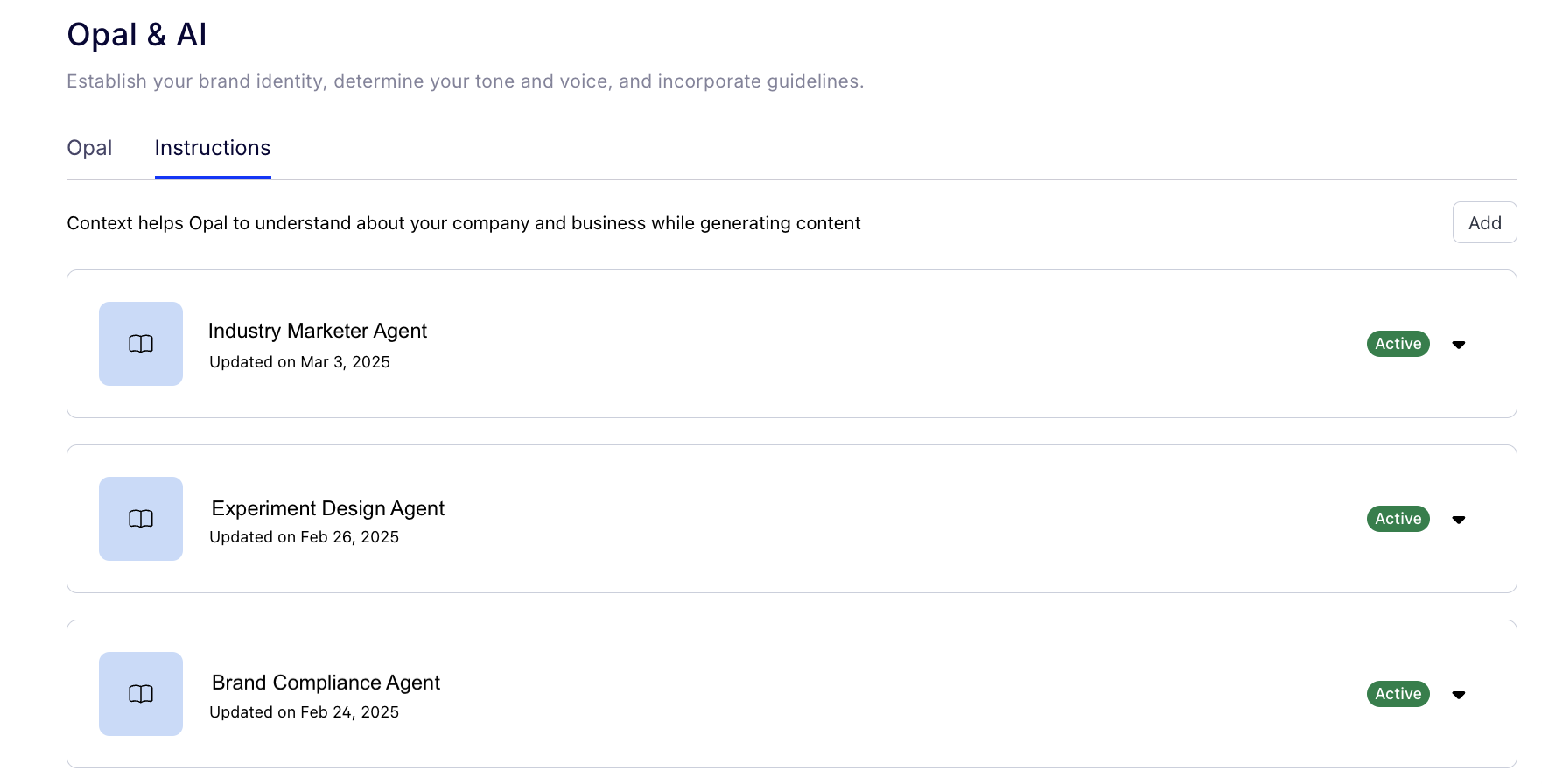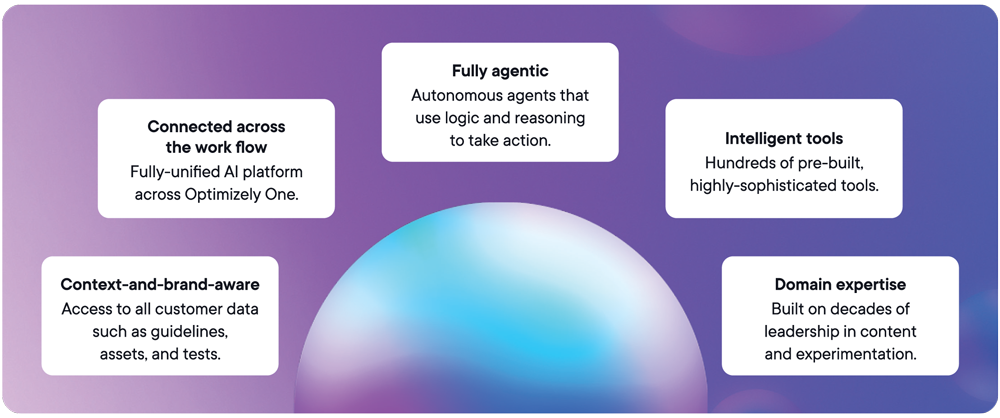Strong product content is a competitive differentiator for B2B ecommerce, especially for manufacturers and distributors. For this reason, many M&D companies are investing months (sometimes years) and thousands of dollars getting the most crucial aspects of content creation right. Today’s customers expect easy to find, detailed product information at every stage of the buying cycle. In the face of enormous M&D catalogs and the need for sophisticated, personalized B2B buyer experiences, building this type of content and keeping it relevant is a Herculean task.
That’s why many commerce leaders are increasingly turning to AI content generators for help. With the right prompts and the right AI content creation tools, content can become a key growth driver, boosting search results, relevance, completeness—and buyer trust.
But the complexity of a strong B2B commerce experience means you can’t just choose any b2b AI writing tool. This is where Optimizely Opal changes the game. Opal can be implemented by manufacturers and distributors to help generate ecommerce product content that is relevant, compliant, AND scalable.
But AI-generated content is only as good as the prompts being used. In this article, the marketing experts at Optimizely offer up:
- The 6 proven elements of strong AI prompts for B2B
- 10 real-world examples of prompts that solve common product content challenges
- Why Optimizely Opal outperforms most generic tools like ChatGPT, Jasper, and Writer
But first, it’s critical to understand why AI is fast becoming a required component for building high-performance M&D ecommerce experiences.
Why AI matters in B2B product content
Using AI to generate ecommerce product content is not just about speed. With the right tool, AI- generated content can help overcome some of the toughest challenges facing B2B ecommerce teams today, including:
- Buyer engagement: Specific, relevant product content builds trust at every touchpoint in the B2B buying cycle. The right AI prompts can create benefit-driven copy, personalized recommendations and promotions, and complete, descriptive attributes that keep buyers coming back.
- Scalability: M&D catalogs can contain tens of thousands of SKUs, making it impossible to manually create and maintain consistent, complete content. When trained specifically on a company’s catalog, brand rules, and industry regulations, AI tools can generate strong prompts and content in minutes.
- Searchability: SEO-optimized copy dictates a product’s discoverability for busy B2B buyers. An AI tool designed for complex M&D catalogs can identify keywords and create optimized descriptions that boost visibility, without hours of research.
- Completeness: Missing important product details leads to frustrated buyers and abandoned carts. AI can identify gaps by comparing your catalog to competitors and build content to drive customers all the way through checkout.
- Global Capability: Entering new markets requires translation, localization and even some knowledge of cultural habits and preferences. AI can accelerate this work while matching brand tone, ensuring compliance, and building local SEO relevance.
What makes a good AI prompt?
If AI is the engine, prompts are the fuel. A vague instruction like “Write a product description” will produce equally generic copy. A well-structured prompt, on the other hand, can generate accurate, SEO-ready, and brand-compliant content.
The Optimizely team comes with decades of experience in B2B ecommerce and as a result has developed a set of 6 best practices that good B2B prompts must align with:
- Know the specific goal and task at hand to help define the exact output: Be sure to explain which measurement the content must deliver on to be considered successful.
- Understand the context: State where the content will be used, such as a product detail page or marketplace listing.
- Define the chosen audience: This helps create content that speaks to specific targeted buyers, from procurement managers, to engineers, or even end-users.
- Use the correct tone: Your content must align with brand guidelines while using a voice that delivers the desired goal, whether it’s technical, conversational, or persuasive.
- Specify formats: Do you need a set of simple bullets, a meta description, or longer copy that helps educate buyers? Make sure the AI tool understands how this content should appear.
- Acknowledge constraints: This might include set word counts, SEO requirements, compliance rules and regulatory parameters.
Granted, you could use these best practices to write your own prompts manually, but it would be quite a chore. With generic AI tools, it can be a frustrating endeavor to include them in every prompt.
With Opal, however, teams don’t need to repeat themselves every time. Tools like brand guidelines, tone and voice, specifications, compliance requirements and the more are configured once (see below). Applied automatically, they ensure every output aligns with business needs so your team can focus on more important tasks.

10 AI prompt examples for better B2B ecommerce product content
Here are 10 ready-to-copy-and-paste prompts! Identify your key pain points and leverage the appropriate prompt to resolve them.
Pain point: Low engagement caused by a lack of compelling, benefit-driven content.
PROMPT: I'm struggling to write engaging product descriptions that truly highlight the value for our target buyers. Can you generate 5 unique, benefit-driven descriptions per product for our new line of industrial pumps, emphasizing their energy efficiency and durability, specifically for procurement managers?
Pain point: Missed sales due to poor marketplace product searchability/discoverability, leading to missed sales opportunities.
PROMPT: Our products aren't showing up high enough in search results. Can you analyze our top 10 selling products and suggest SEO-optimized titles and meta descriptions, including relevant long-tail keywords, to improve their visibility on major search engines?
Pain point: Customer frustration and cart abandonment due to incomplete product data/attributes.
PROMPT: Customers are complaining about missing information on our product pages, and it's impacting sales. Can you review our Power Tools product category, identify essential attributes missing compared to competitors such as voltage, weight, or material? Suggest a plan to fill these gaps.
Pain point: Internal inefficiencies and poor buyer experience due to inconsistent product data/taxonomy across the catalog.
PROMPT: Our product data is a mess, especially with variations like color, which makes filtering difficult for customers and managing our catalog internally a nightmare. Can you help me standardize the color attributes across our entire electronics catalog by providing a list of common color variations and their standardized values (e.g., 'navy blue' -> 'Blue', 'charcoal' -> 'Grey')? Please include hex/RGB codes.
Pain point: Unacceptable site performance and poor customer engagement due to suboptimal media assets.
PROMPT: Our mobile site performance is suffering due to large image files, and some products lack compelling visuals. For our Outdoor Furniture' collection, can you suggest a strategy for optimizing product images and videos for faster loading times on mobile devices without compromising visual quality? Please identify any products that are missing high-resolution lifestyle imagery.
Pain point: Difficulty scaling content rapidly for international markets while maintaining linguistic and cultural accuracy.
PROMPT: We need to expand into Europe quickly, but translating and localizing all our product content is a huge bottleneck. Can you translate and localize the product specifications and marketing copy for our Smart Home Devices into German and French, ensuring cultural relevance and accuracy for those markets? Maintain SEO relevance for local search terms.
Pain point: Negative impacts on differentiation and market positioning due to lack of competitive insight into product content strategies.
PROMPT: I need to understand how our competitors are presenting their products online so we can differentiate ourselves. Can you perform a competitive analysis on [Competitor A]'s and [Competitor B]'s product listings for Commercial Lighting Solutions highlighting their unique selling propositions, pricing strategies, and content presentation, and suggest areas where we can differentiate? Highlight content format differences including product videos and comparison charts.
Pain point: Inability to effectively personalize product discovery and recommendations, leading to missed cross-sell/upsell opportunities.
PROMPT: We're missing out on cross-sell and upsell opportunities because our product recommendations aren't tailored enough. Generate personalized product recommendation rules (cross-sell and upsell) for product detail pages in the Automotive Parts category, based on typical customer behavior.
Pain point: Risk of non-compliance with industry-specific regulations due to inaccurate or non-standardized content.
PROMPT: I'm concerned our Food & Beverage product catalog content might not be fully compliant with FDA labeling guidelines. Can you review it and suggest any necessary disclaimers, ingredient lists formatting changes to ensure we meet all regulatory requirements? Suggest international equivalents where relevant.
Pain Point: Slow content creation processes for new product launches, delaying time-to-market.
PROMPT: Our new product launches are constantly delayed because content creation takes too long. For an upcoming launch of 30 new Agricultural Equipment accessories, can you rapidly generate initial product titles, short descriptions, and key feature bullet points, drawing from the technical specifications I'll provide? Please create content in a format easily synced to our PIM/ERP system.
Why not just use ChatGPT?
“With Opal, we’ve created an AI tool purpose-built for your organization and embedded in your marketing team’s workflows It’s finely tuned to align every output with measurable business outcomes.”
– Trevor Pope, Senior Director of Solution Architecture, Optimizely.
ChatGPT and similar tools may be fine for general AI exploration, but Opal was built for the governance, integration, and outcomes that marketers and ecommerce teams require. When compared, there are some major differences between generic AI tools and Opal that are important to consider such as.
- Governance and consistency: While most AI tools can produce copy quickly, they don’t reliably enforce brand tone, compliance standards, or formatting needs, leaving teams with extra editing work. Opal bakes governance into every output, so consistency is automatic.
- Workflow integration: Other AI content creation tools exist outside your systems, forcing teams to copy and paste. Opal is fully integrated into Optimizely’s Configured Commerce, Content Marketing, and Experimentation platforms, ensuring content is generated in the right format and flows directly into your systems.
- Scalability with complex, large catalogs: Generic AI wasn’t designed for thousands of SKUs and complex M&D taxonomies. Opal is uniquely suited to handle the scale and complexity of B2B product catalogs.
- Outcome-driven results: Any AI tool can deliver “words on a page.” With Opal, marketers and catalog managers can deliver business results including improved engagement, conversions, and faster time-to-market.
Optimizely Opal: The strategic alternative to generic AI
Opal builds on the best aspects of AI and powers up its capabilities even more by ensuring every piece of content is compliant, consistent, and connected directly to your workflows. The result isn’t just faster product copy production —it’s content that drives all the key performance indicators of a strong bottom line.

Try the 10 prompts in your own workflow and see how AI transforms product content creation. Then explore how Opal can take the guesswork out of prompting, automate compliance, and scale product content for manufacturers and distributors.
- Last modified: 11/4/2025 5:34:16 PM
